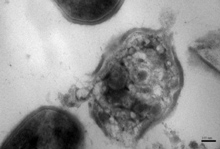

This week MIT's Technology Review reported that IBM researchers are developing nanoparticles that kill bacteria by poking holes in them. The hope is that bacteria will be less successful at developing a resistance to these types of drug, leaving doctors with a powerful tool in the fight against antibiotic-resistant microbes.
Success in early testing has shown positive results, and it is hoped that the new technology will eventually help curb the growing problem of antibiotic resistance. In 2005 alone, some 95,000 people in the U.S. developed a life-threatening staph infection resistant to multiple antibiotics, according to the U.S. Centers for Disease Control and Prevention.
The article reports on the science behind the technique used by researchers in IBM's Alamaden Lab in San Jose as follows:
[Researchers] took advantage of past work on a library of polymer building blocks that can be mixed and matched to make complex nanoparticles. To make a nanoparticle that would selectively attack bacterial membranes and then break down harmlessly inside the body, the IBM group put together three types of building blocks. At the center of the polymer sequence is a backbone element that's water-soluble and tailored to interact with bacterial membranes. At either end of the backbone is a hydrophobic sequence. When a small amount of these polymer chains are added to water, the differences between the ends and the middle of the sequence drive the polymers to self-assemble into spherical nanoparticles whose shell is entirely made up of the part that will interact with bacterial cells.
The work of the researchers is more fully described in this week's issue of Nature Chemistry.
Testing has only been done with human blood in mice at this stage, but researchers say results lead them to believe their work will be successful in humans. The article reports that IBM has no stated hopes of entering the pharmaceutical business, but that it will partner with a health care company to license the polymer drugs. For more details, see the complete article in Technology Review.


